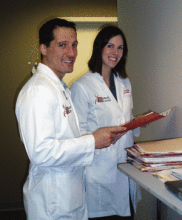MIAMI - A considerable drop in patient wait time, less stress for the dermatologist, and an increase in revenue "more than pays for" hiring a physician extender, said Dr. Matthew J. Zirwas.
Advice on how to hire the right person and how to staff the patch test protocol so patient satisfaction remains high was offered by Dr. Zirwas at the meeting. Sarah Otto, a certified nurse practitioner, also provided her perspective on working as Dr. Zirwas' physician extender.
"The best thing I've done as a patch tester is to bring Sarah on," said Dr. Zirwas of Ohio State University, Columbus. On average, patients wait 6.3 months for patch testing, based on 100 responses from American Contact Dermatitis Society members surveyed by Dr. Zirwas and his colleagues (Dermatitis 2010;21:98-101).
At Ohio State, the wait time for patch testing is 6-9 months, which, Dr. Zirwas said, "is really not acceptable for someone with an itchy rash."
"We were able to decrease [the average wait] from 6-9 months to 3 months," Ms. Otto said. At the same time, the average number of patients per week increased from 12 to 20.
"The additional revenue more than pays for the certified nurse practitioner," Dr. Zirwas said.
The study also showed that physicians used testing trays that contained an average of 62 allergens. Of the respondents, 68% used the North American Contact Dermatitis Group series, 94% reported using the Contact Allergen Replacement Database (CARD) test regularly, while only 9% used the thin-layer rapid-use epicutaneous (TRUE) test because of its low number of allergens. He and his colleagues concluded that CARD use should be encouraged.
After training with Dr. Zirwas in the clinic for 3 months, Ms. Otto began handling all initial patient consultations. "She leaves me more time to do the things I want to do," Dr. Zirwas said. "She really picks up a lot of … the things I don't like to do, for example, writing or sending letters."
He still sees all patch test patients, but is less stressed and has more fun at work now, he added.
"I take history and choose panels, and then present the patient to Dr. Zirwas," Ms. Otto said. "Dr. Zirwas adjusts the plan as needed."
Referring physician and patient acceptance of the physician extender was an initial concern, Dr. Zirwas said.
"We were worried patient satisfaction would be compromised because of less interaction with the physician." Ms. Otto said.
So they administered an internal patient satisfaction exit survey. They found, for example, that 94% of patients responded with a 4 or better (on a 1-5 scale) when asked, "Were you given enough time to explain your rash to the health care provider?" Also, 100% replied with a 4 or better when asked, "Did you have confidence in the knowledge of the health care provider(s) you saw today?"
"Based on these results, we did not think patient satisfaction had been impacted by my presence at Ohio State," Ms. Otto said.
Almost 30% of dermatologists currently work with a physician extender, including both nurse practitioners and physician assistants (J. Am. Acad. Dermatol. 2008;58:211-6).
Dr. Zirwas prefers nurse practitioners. "Nurse practitioners are nurses who have additional training so they can [make] independent medical decisions," he said. "Physician assistants are a little less trained in terms of making independent medical decisions, and are more trained to be an assistant to the physician than an independent provider."
Find someone who "enjoys working with the MD--I cannot emphasize this too much," Dr. Zirwas said. Also search for an extender who demonstrates a desire to learn new things, wants to grow professionally, and has at least several years of dermatology experience, he added. Ms. Otto had 3 years of previous general dermatology experience.
How much independence a physician extender should have is an unanswered question, Dr. Zirwas said. "When I'm out of town at a meeting, right now Sarah is not patch testing anyone. I think we will get to the point where internally referred patients can be patch tested by Sarah."
Disclosures: Dr. Zirwas and Ms. Otto had no relevant financial conflicts.


